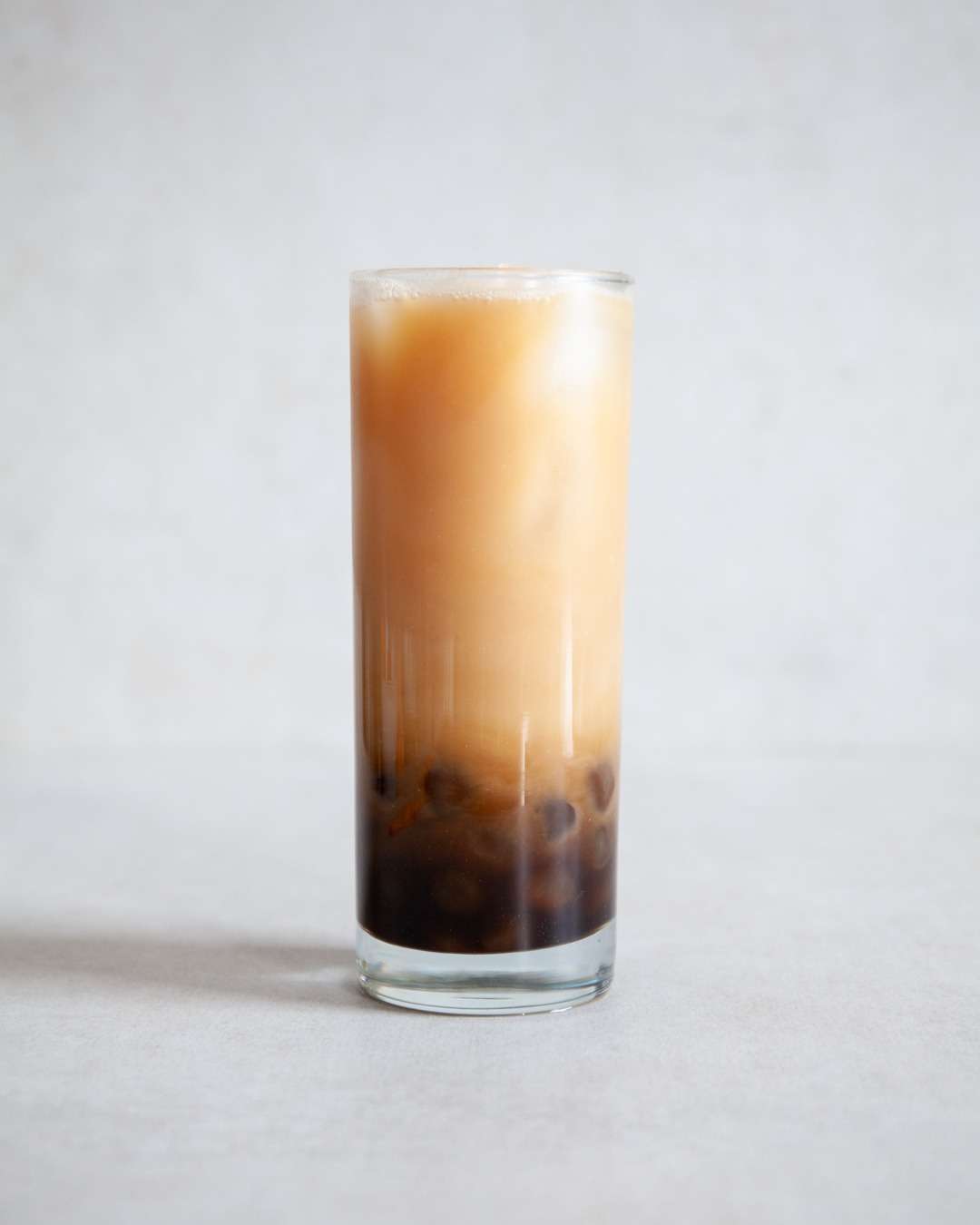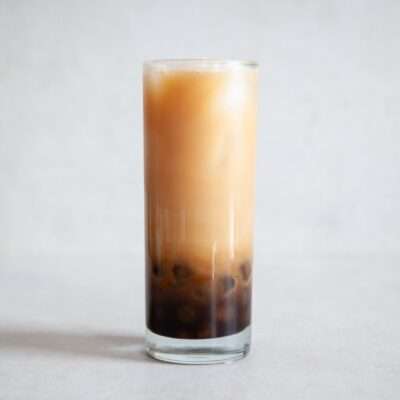Potato Boba Tea

You can watch the full video here.
What are Boba Pearls
Boba pearls are small, chewy balls that are usually made from tapioca starch. They are typically served in boba tea, a popular Taiwanese beverage that combines the pearls with a mix of milk and tea.
The pearls are usually cooked in boiling water until they become translucent and soft, and then they are sweetened with a simple syrup. The texture of boba pearls is unique and slightly chewy, making them a fun addition to any beverage.
Although they are usually made from tapioca starch, you can extract your own potato starch and apply the same process to make boba pearls from scratch. The full recipe for the pearls, milk, syrup and tea is below.
makes 2x 300 ml
Ingredients
Boba Pearls
-
30ml water
-
25g dark brown sugar
-
55g homemade potato starch + extra for dusting
Sugar Syrup
-
80ml water
-
100g dark brown sugar
Flavoured Tea with Potato Milk
-
1 tbsp loose black tea (Assam)
-
150g leftover grated potatoes
-
25g oats
Method
If you make your own potato starch, make sure to keep some of the leftover grated potatoes aside in the fridge to make the potato milk later on.
For the pearls, bring the water and sugar to a boil over low heat until all of the sugar has melted. Stir in a quarter of the potato starch until well combined into a slurry, then mix in another quarter and turn off the heat. Now add the rest of the starch bit by bit until the slurry begins to thicken considerably (if you add the starches all at once, it will turn into gelatinous clumps and your dough is ruined, so go slowly). When you’ve added all of it, use the spoon or spatula to shape it into a rough dough.
Transfer the dough to a clean surface, dust it with a little more potato starch and knead until smooth, adding more starch if it is sticking to the surface.
Dust a shallow bowl with some potato starch and set aside. Divide the dough into four equal pieces, roll each piece into a log, then cut each log into small pieces roughly the same size of the hole of the straw, keeping in mind that they will swell up a little while cooking (if you have a micro scale, make sure that each piece is 0.70g or less). Roll each piece into a pea-sized ball and drop it into the bowl with the starch to avoid it from sticking.
Bring a pan of water to a boil. Tip the pearls into a sieve and shake gently to remove the excess starch, then drop them into the boiling water. Wait for them to float, then stir them and simmer for 30 minutes. Turn off the heat, cover the pan with a lid and let the pearls rest for another 30 minutes.
In the meantime, make the sugar syrup by combining the dark brown sugar with 80 ml water in a small pan. Bring it to a boil, then simmer until all of the sugar has dissolved and it begins to bubble rapidly. Set aside to cool.
For the tea, steep the loose black tea in 300 ml boiling water for 5 minutes. Then strain and refrigerate to cool off. To make your own potato milk, bring some water to boil and cook the leftover grated potatoes for 5 minutes. Drain and cool them under cold running water, then add to a blender along with the oats and 600 ml water. Blend for around 30 seconds, then strain through a cheesecloth before filling the milk into a bottle and refrigerating it for later.
When the boba pearls are ready, drain them through a sieve and transfer them to ice water to cool off. Drain them again and transfer to a bowl along with 2 tbsp of the prepared sugar syrup.
To assemble the boba tea, add a tablespoon of the pearls to a hiball glass along with an extra tablespoon of syrup. Fill the glass with ice cubes, then pour in the black tea followed by the potato milk. Mix with a spoon or straw to dissolve the syrup, before drinking it through a wide boba tea straw.
Storage: The pearls don’t keep well in the fridge, so try to consume them the same day.

Potato Boba Tea
Ingredients
Boba Pearls
- 30 ml water
- 25 g dark brown sugar
- 55 g homemade potato starch + extra for dusting
Sugar Syrup
- 80 ml water
- 100 g dark brown sugar
Flavoured Tea with Potato Milk
- 1 tbsp loose black tea Assam
- 150 g leftover grated potatoes
- 25 g oats
Instructions
- If you make your own potato starch, make sure to keep some of the leftover grated potatoes aside in the fridge to make the potato milk later on.
- For the pearls, bring the water and sugar to a boil over low heat until all of the sugar has melted. Stir in a quarter of the potato starch until well combined into a slurry, then mix in another quarter and turn off the heat. Now add the rest of the starch bit by bit until the slurry begins to thicken considerably (if you add the starches all at once, it will turn into gelatinous clumps and your dough is ruined, so go slowly). When you’ve added all of it, use the spoon or spatula to shape it into a rough dough.
- Transfer the dough to a clean surface, dust it with a little more potato starch and knead until smooth, adding more starch if it is sticking to the surface.
- Dust a shallow bowl with some potato starch and set aside. Divide the dough into four equal pieces, roll each piece into a log, then cut each log into small pieces roughly the same size of the hole of the straw, keeping in mind that they will swell up a little while cooking (if you have a micro scale, make sure that each piece is 0.70g or less). Roll each piece into a pea-sized ball and drop it into the bowl with the starch to avoid it from sticking.
- Bring a pan of water to a boil. Tip the pearls into a sieve and shake gently to remove the excess starch, then drop them into the boiling water. Wait for them to float, then give them a stir and simmer for 30 minutes. Turn off the heat, cover the pan with a lid and let the pearls rest for another 30 minutes.
- In the meantime, make the sugar syrup by combining the dark brown sugar with 80 ml water in a small pan. Bring it to a boil, then simmer until all of the sugar has dissolved and it begins to bubble rapidly. Set aside to cool.
- For the tea, steep the loose black tea in 300 ml boiling water for 5 minutes. Then strain and refrigerate to cool off. To make your own potato milk, bring some water to boil and cook the leftover grated potatoes for 5 minutes. Drain and cool them under cold running water, then add to a blender along with the oats and 600 ml water. Blend for around 30 seconds, then strain through a cheesecloth before filling the milk into a bottle and refrigerating it for later.
- When the boba pearls are ready, drain them through a sieve and transfer them to ice water to cool off. Drain them again and transfer to a bowl along with 2 tbsp of the prepared sugar syrup.
- To assemble the boba tea, add a tablespoon of the pearls to a hiball glass along with an extra tablespoon of syrup. Fill the glass with ice cubes, then pour in the black tea followed by the potato milk. Mix with a spoon or straw to dissolve the syrup, before drinking it through a wide boba tea straw.
Notes
